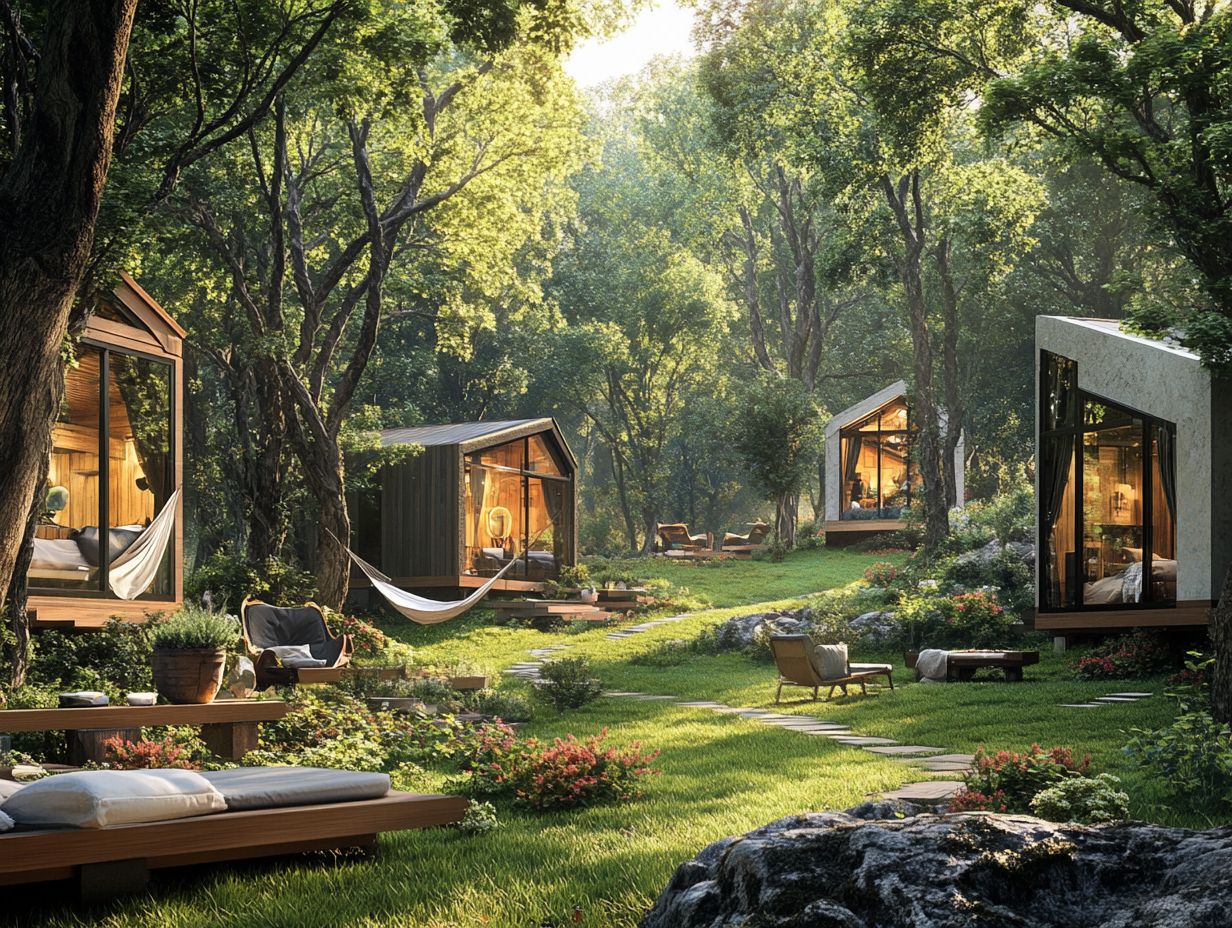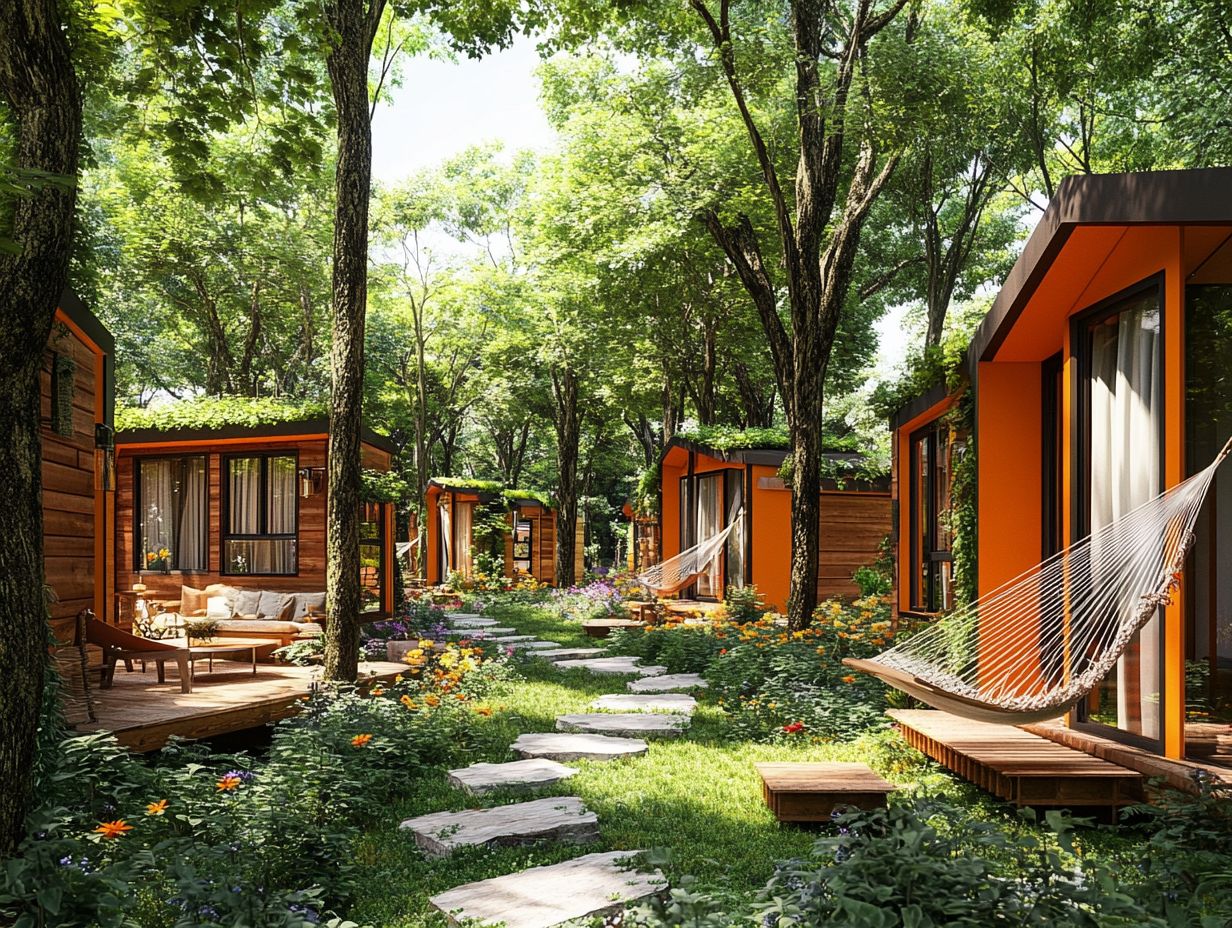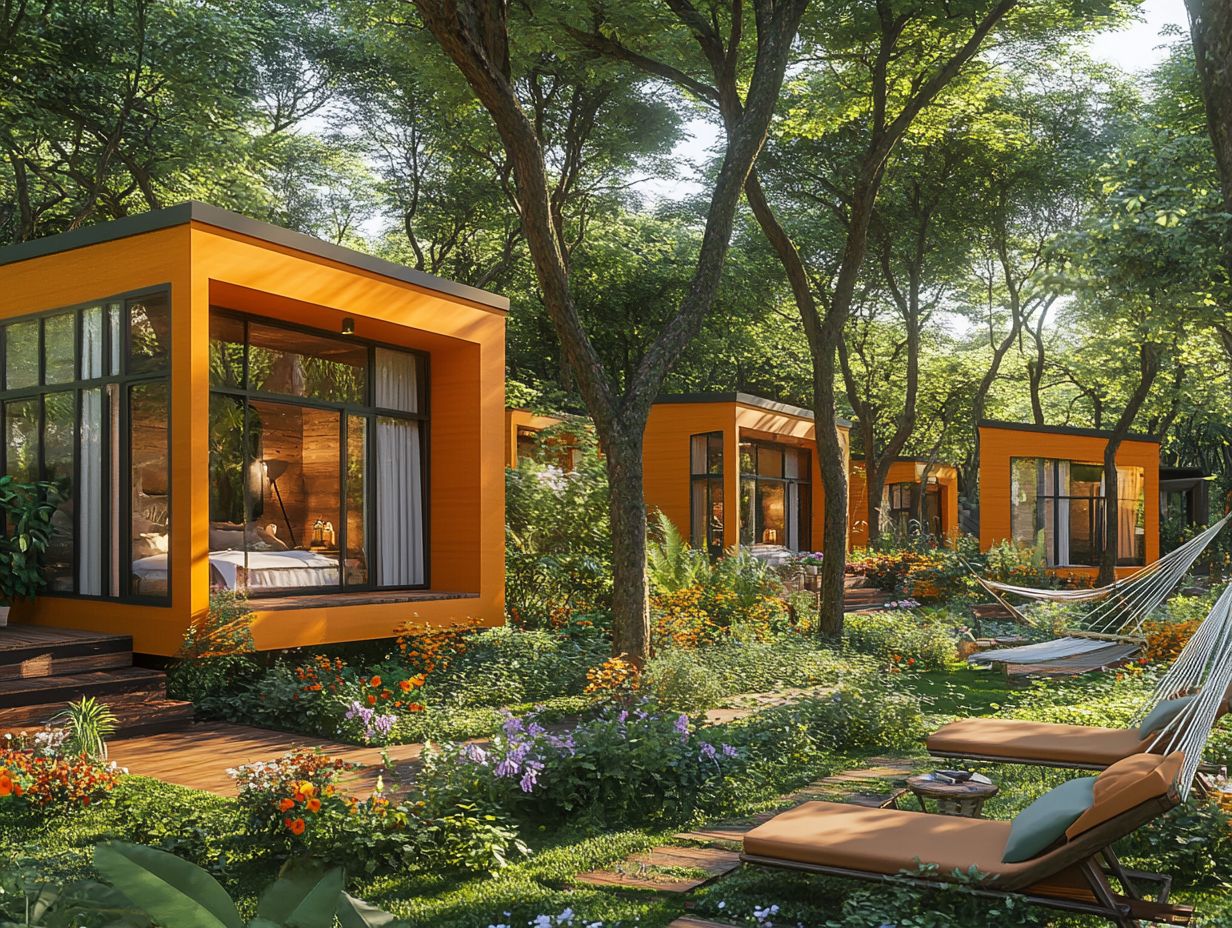8 Ideal Locations for Tiny House Living
If you ve ever envisioned a life of simplicity, where you can embrace a more sustainable lifestyle, tiny house living may very well be your gateway to freedom.
This article delves into eight breathtaking locations that are perfectly suited for your tiny home whether you re drawn to tranquil mountainside retreats or lively urban environments.
Get ready to discover the benefits and challenges of tiny house living, important legal considerations to bear in mind, and the essential features that make a location truly ideal.
Prepare to uncover the perfect setting for your tiny living adventure!
Contents [hide]
- Key Takeaways:
- 1. Mountainside Retreat
- 2. Beachfront Property
- 3. Wooded Wonderland
- 4. Lakeside Oasis
- 5. Urban City Living
- 6. Desert Escape
- 7. Countryside Charm
- 8. Island Paradise
- What Are the Advantages of Living in a Tiny House?
- Frequently Asked Questions
- 1. What are the benefits of tiny house living?
- 2. What are the top 8 ideal locations for tiny house living?
- 3. Why are mountains an ideal location for tiny house living?
- 4. What makes living in a forest a good choice for tiny house living?
- How does living lakeside promote a sustainable lifestyle for tiny house owners?
- What are the benefits of living on a beach in a tiny house?
- Why is the countryside a popular location for tiny house living?
- Can tiny house owners live in urban areas?
Key Takeaways:

- Experience peace and tranquility in a mountainside retreat, perfect for those seeking a quiet and secluded living space.
- Embrace the coastal lifestyle in a beachfront property, where you can wake up to stunning views and the sound of waves.
- Surround yourself with nature in a wooded wonderland, where you can live sustainably and connect with the great outdoors.
1. Mountainside Retreat
A mountainside retreat provides you with a serene escape into nature, allowing you to fully embrace the beauty of tiny house living amidst stunning mountain views. This setting is perfect for creating a tiny home that promotes peace and connections with others.
In such picturesque surroundings, you can engage in a variety of outdoor activities year-round, from hiking and skiing to mountain biking and bird watching. The close-knit tiny home communities often encourage a spirit of collaboration and friendship, enhancing your living experience.
Events like TinyFest California connect enthusiasts to share innovative designs and sustainable living practices that resonate with those seeking a simpler lifestyle. Here, the celebration of tiny house culture is palpable, reinforcing the joys of living small in the great outdoors.
2. Beachfront Property
Owning a tiny house on beachfront property offers you a unique lifestyle that beautifully merges the simplicity of tiny living with breathtaking ocean views, especially in sought-after coastal locations like California and Florida.
In this idyllic environment, you’ll discover a vibrant sense of community, where neighbors share not just their space but also a passion for outdoor activities be it surfing, paddleboarding, or cozy beach bonfires under a starlit sky.
Living in these lively coastal towns allows you to embrace a more leisurely pace, focusing on experiences rather than material possessions. The tiny house movement champions sustainable living, encouraging eco-friendly practices while enhancing your enjoyment of the stunning natural surroundings.
With the calming sound of waves as your constant companion, you ll likely find yourself drawn into an active lifestyle that balances adventure with mindfulness. This blend makes the coastal tiny home experience not just appealing but truly transformative.
3. Wooded Wonderland
A wooded wonderland is the perfect backdrop for your tiny house dreams, offering a serene retreat that fully embraces the tiny house movement. In states like Maine and Minnesota, where dense forests envelop you in privacy, this lifestyle becomes a sanctuary of peace.
Imagine waking up each morning to the gentle sounds of rustling leaves and cheerful birdsong, crafting a harmonious atmosphere that invites relaxation and mindfulness into your daily routine. The stunning scenery surrounding your tiny home in such lush environments not only elevates your physical well-being but also sparks inspiration for your artistic endeavors and personal reflection.
Embracing the simplicity of tiny living encourages you to minimize material possessions, deepening your connection with both the land and your community. This shift ultimately paves the way for a more fulfilling and sustainable lifestyle, where every moment is enriched by nature s beauty.
Start planning your tiny house journey today!
4. Lakeside Oasis
Imagine a lakeside oasis as your ideal setting for tiny house living. You can immerse yourself in the soothing embrace of water views and endless outdoor recreation. In states like Arkansas, the picturesque lakeside landscapes create the perfect backdrop for charming tiny home communities.
The appeal of life by the water goes far beyond stunning scenery. It cultivates a vibrant sense of community that many find utterly irresistible. As an outdoor enthusiast, you will have a wealth of activities at your fingertips think fishing, kayaking, and hiking transforming every weekend into an exhilarating adventure.
In these close-knit tiny home neighborhoods, connections flourish among residents. Friendships blossom over shared experiences like community barbecues and sunset picnics by the shore. This unique combination of recreation and camaraderie elevates lakefront living into a lifestyle brimming with joy and excitement.
5. Urban City Living
Urban living in a tiny house offers a contemporary solution for those seeking affordability and convenience. This is particularly true in densely populated regions like New Jersey and Georgia, where tiny home prices can be significantly lower than traditional housing options.
This new way of living not only alleviates financial pressures. It also fosters a more sustainable way of life. You will often find yourself just a short walk or bike ride from essential amenities like grocery stores, parks, and public transport making your daily routine simpler and minimizing your need for a car.
Tiny home communities cultivate a sense of belonging. This allows you to connect with like-minded individuals who value minimalist living. Each tiny house typically requires less energy to maintain, which means your environmental footprint is reduced. This perfectly aligns with the growing emphasis on eco-friendly practices in urban environments.
6. Desert Escape

Imagine a stunning desert escape, perfect for tiny house living! Sustainability methods thrive in arid climates. This setting showcases the adaptability of the tiny home movement, particularly in regions like Texas and Arizona, which embrace minimalist lifestyles.
In these challenging landscapes, you will find innovators reimagining living spaces with a keen focus on energy efficiency and water conservation essential elements when resources are scarce. The relentless sun inspires designs that harness solar power, and the rugged terrain encourages residents to minimize their ecological footprint.
As you transition to these tiny havens, you will likely adopt a more mindful approach to consumption. This shift cultivates a deeper connection with nature and enhances your appreciation for sustainable living.
Ultimately, this lifestyle transformation not only redefines your home but also nurtures a community ethos centered around resourcefulness and environmental stewardship.
7. Countryside Charm
Experiencing the charm of the countryside in a tiny house invites you to fully embrace the simplicity and beauty of rural living. In places like Kentucky and Alabama, you will discover the myriad advantages of tiny home life, where communities tend to be more connected and welcoming.
This lifestyle nurtures a profound sense of belonging as neighbors rally together to support one another. This fosters enduring friendships and a spirit of camaraderie. Living affordably without compromising on quality of life opens up opportunities for you to spend more time outdoors, allowing for a genuine connection to nature that many urban dwellers often miss.
The breathtaking landscapes offer not just relaxation; they also serve as a playground for a variety of outdoor activities. In this environment, you will find joy in both sustainable living and cultivating local relationships, enriching your daily life in truly meaningful ways.
Ready to join the tiny house movement? Discover your perfect home today!
8. Island Paradise
Living in a tiny house on an island paradise invites you into a laid-back lifestyle defined by breathtaking views and a close-knit community. In places like Florida and Maine, tiny home enthusiasts find themselves surrounded by like-minded individuals who share a passion for simplicity and connection.
These unique communities cultivate deep bonds among residents. They foster collaboration and shared experiences that enrich daily life. Embracing the minimalist nature of tiny house living encourages you to prioritize quality over quantity, leading to more meaningful interactions and a greater appreciation for what truly matters.
Your environmental footprint shrinks significantly in this setting. Residents adopt sustainable practices like using solar power and collecting rainwater, perfectly aligning with the island s natural vibe. Island life inspires you to adapt to your surroundings. Cultivating local gardens and selecting eco-friendly materials become second nature while you bask in the serene beauty of such idyllic locales.
What Are the Advantages of Living in a Tiny House?
Living in a tiny house offers a multitude of advantages, from lower living costs and a reduced environmental footprint to the chance for a simpler lifestyle. This option excites those looking for sustainable housing solutions!
But the benefits go beyond just financial savings. Embracing a minimalist lifestyle often leads to increased mental clarity and emotional well-being. With fewer possessions to juggle, you can focus more on experiences rather than material goods, nurturing deeper connections with family and friends.
The energy-efficient designs typical of tiny houses use less energy and contribute to environmental sustainability. This significantly cuts down on utility bills while promoting eco-friendly practices. Ultimately, choosing this lifestyle allows you to align your living choices with your values, creating a harmonious balance that fosters personal growth and fulfillment in a more mindful way.
What Are the Challenges of Living in a Tiny House?
However, tiny house living comes with its own set of challenges that you’ll need to tackle head-on! These include zoning laws, limited space, and the potential social stigma surrounding tiny homes.
These hurdles can feel daunting, especially if you’re looking to downsize or embrace a more minimalist lifestyle. Zoning regulations vary significantly from one municipality to another, making it challenging to find suitable land for your compact dwelling. To help you navigate this, consider exploring the best location for a tiny house.
The limited square footage requires you to be exceptionally creative with your storage solutions and layouts, which can sometimes lead to frustration. Society’s views on tiny homes can lead to misunderstandings, as many people might consider them unconventional or even impractical, adding an emotional layer to your aspirations of this unique way of living.
What Are the Legal Considerations for Tiny House Living?
Understanding the legal considerations for tiny house living is essential for you as a prospective owner. This includes zoning regulations, building codes, and community guidelines that dictate where and how tiny homes can be established.
Navigating this intricate web of laws can often feel challenging, especially since these regulations vary from one municipality to another. Some towns embrace tiny living by designating specific zones where these smaller dwellings are welcomed, while others impose restrictions that could stifle growth and sustainability.
As you embark on your tiny home journey, it’s crucial to understand factors like minimum lot sizes, setback requirements, and utility regulations. These all heavily influence your housing options. To find the ideal place for your tiny home, consider exploring the best tiny house locations. Local governments may have unique criteria aimed at preserving the character of their neighborhoods, leading to a patchwork of approvals and challenges for those eager to become part of tiny home communities.
How Can One Find the Perfect Location for Their Tiny House?

Finding the perfect location for your tiny house requires careful consideration of factors such as accessibility, community, and legal restrictions. It’s essential that the chosen spot aligns with your lifestyle preferences and vision for your tiny home.
Start by researching various tiny house communities. These areas foster a supportive environment that can enhance your living experience. Explore online forums and local social media groups focused on tiny living to gain valuable insights into available plots and the overall vibe of the community. Additionally, consider 8 ways to make your tiny house feel spacious to maximize your space.
Understanding local zoning laws, or the rules about where you can place your tiny house, is crucial. Regulations can vary significantly from one municipality to another. By checking city or county codes along with any applicable homeowner association rules, you’ll be better equipped to navigate the complex landscape of tiny house living, including 8 ways to make your tiny house eco-friendly.
What Are the Must-Have Features for a Tiny House Location?
When choosing a location for your tiny house, consider essential features such as:
- Access to vital services
- A supportive community
- Sustainability initiatives that align with the tiny house movement
These elements not only ensure everyday convenience but also elevate your living experience. Being close to nature allows you to enjoy hiking trails, parks, and outdoor activities just a short distance from your front door.
A vibrant community offers resources like local farmers’ markets and cooperative workshops, fostering meaningful connections among residents and a sense of belonging.
By embracing sustainable practices like solar energy and water conservation, you minimize your ecological footprint while cultivating a lifestyle deeply rooted in environmental stewardship.
Is Tiny House Living Sustainable in These Locations?
Tiny house living offers a sustainable lifestyle that can thrive in various locations. It is influenced by environmental factors, community support, and your personal commitment to sustainability. This approach brings numerous benefits, not just for you, but for the planet as a whole.
This lifestyle adapts remarkably well to urban, suburban, or rural settings, each presenting unique challenges and advantages. In urban areas, you can leverage shared spaces and community gardens, fostering collaboration while reducing your carbon footprint. Conversely, in rural settings, you can utilize natural resources by embracing off-grid living and eco-friendly practices like rainwater harvesting and composting.
The adaptability of tiny houses minimizes your ecological footprint and nurtures vibrant, sustainable communities focused on local engagement and environmental stewardship, as outlined in these 8 tips for a sustainable tiny house lifestyle.
Frequently Asked Questions
1. What are the benefits of tiny house living?
Tiny house living promotes a tiny home lifestyle centered around simplicity, community, and sustainability, focusing on the advantages of tiny house benefits.
2. What are the top 8 ideal locations for tiny house living?
The top 8 ideal locations for tiny house living are:
- Mountains
- Forests
- Lakeside
- Beach
- Countryside
- Urban areas
- Backyard
- Communities specifically designed for tiny houses
3. Why are mountains an ideal location for tiny house living?

Mountains offer a serene and peaceful environment with beautiful views and access to nature. They provide privacy and a sense of isolation, perfect for those seeking a quiet, minimalist lifestyle.
4. What makes living in a forest a good choice for tiny house living?
Forests provide a close connection to nature and a peaceful setting. They offer ample space for outdoor activities and a chance to live in harmony with the environment.
Ready to find your perfect tiny house location? Start your journey today!
How does living lakeside promote a sustainable lifestyle for tiny house owners?
Lakeside living allows easy access to water. This is essential for sustainable living.
The tranquil and scenic setting provides opportunities for outdoor activities like fishing and boating.
What are the benefits of living on a beach in a tiny house?
Living on a beach offers a laid-back lifestyle with constant access to the ocean. Enjoy stunning views and a sense of community with fellow beach dwellers.
Why is the countryside a popular location for tiny house living?
The countryside has a slower pace and affordable land options for tiny house owners. It fosters a close-knit community and supports sustainable, off-grid living.
Can tiny house owners live in urban areas?
Yes, some cities allow tiny house living under local rules about where tiny houses can be placed. Urban areas provide convenience and access to amenities, though land or rental costs can be higher.
Ready to embrace tiny house living? Explore your options today!






